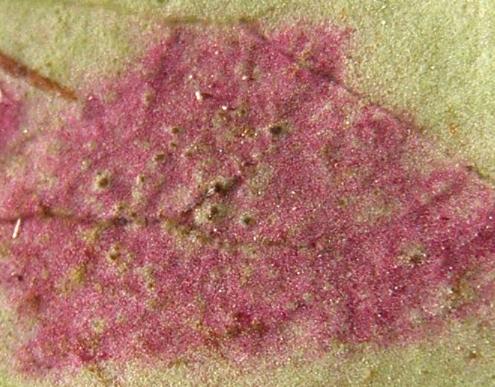
The left and centre images show the upper and lower surfaces of an affected Photinia leaf. The right image is of a fallen leaf which is showing the red pigmentation of juvenile leaves due to the natural senescence process.
This disease affects woody members of the Rosaceae Family but for gardeners it is most notable with the Photinias. Other hosts include pear trees, hawthorn, Pyracantha, Sorbus and quince.

These early lesions were found on young beech tree leaves on a branch which overhung a standard Photinia 'Red Robin' bush that was heavily infected.
This Photinia Scab, as it may be called, attacks mainly fresh growth in the spring and autumn when the warm moist conditions it favours are present - temperatures above 14.5°C, 58°F. Small, bright red spots appear on the upper and lower surfaces of the leaf. These develop grey centres as the infection progresses and the spots may coalesce into larger maroon patches. Tiny black specks within the infected area are fruiting bodies which produce asexual spores (conidia) that are carried to other foliage by water splashes and the wind. Lesions can also appear on leaf petioles and young stems.
If the infection is severe the leaves may be cast as a defensive action by the plant, weakening it and in the worst case may kill it. Usually the badly affected mature leaves are dropped and the shrub looks bare. These fallen leaves can release spores to reinfect new growth.

The small black specks in this more mature lesion are the fruiting bodies.
The fallen leaves carry the disease over the winter and when the humid conditions return spores are released to be taken upwards in water splashes and rising air. Lower leaves are affected first, then the infection progresses further up the plant.
Back to article on Plant Diseases